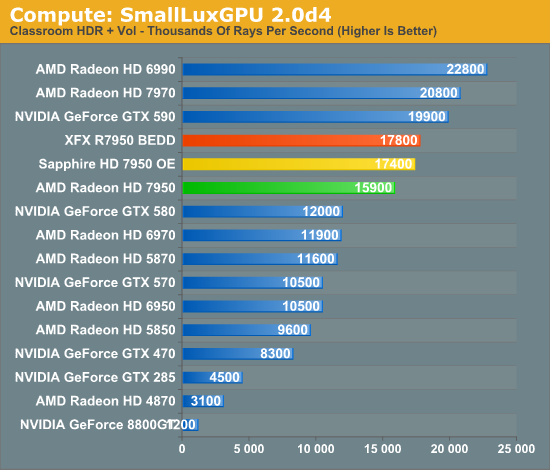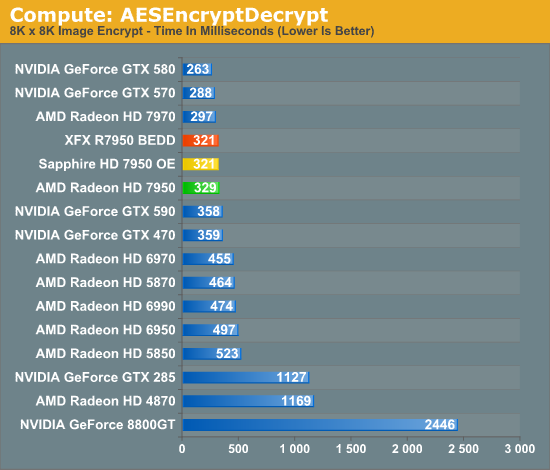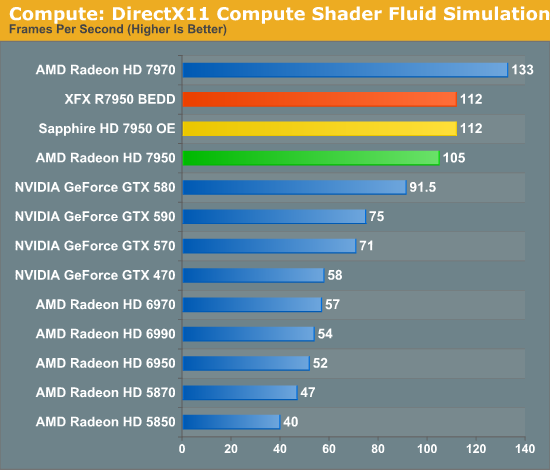AMD Radeon HD 7950 Review Feat. Sapphire & XFX: Sewing Up The High-End Market
by Ryan Smith on January 31, 2012 9:02 AM ESTCompute Performance
Moving on from our look at gaming performance, we have our customary look at compute performance. Since compute performance is by definition shader bound, the 7950 is at a bit of a disadvantage here compared to gaming performance. Whereas ROP performance scales with the core clock, shader performance is hit by both the reduction in the core clock and the disabled CU array.
Our first compute benchmark comes from Civilization V, which uses DirectCompute to decompress textures on the fly. Civ V includes a sub-benchmark that exclusively tests the speed of their texture decompression algorithm by repeatedly decompressing the textures required for one of the game’s leader scenes. Note that this is a DX11 DirectCompute benchmark.

AMD’s greatly improved compute performance continues to shine here, though in the case of Civilization V it’s largely consumed by just closing the previously large gap between the GTX 500 series and the Radeon HD 6000 series. As a result the 7950 falls ever so short of the GTX 580, while the factory overclocked Sapphire and XFX cards give the 7950 enough of a push to come within 5% of the 7970.
Our next benchmark is SmallLuxGPU, the GPU ray tracing branch of the open source LuxRender renderer. We’re now using a development build from the version 2.0 branch, and we’ve moved on to a more complex scene that hopefully will provide a greater challenge to our GPUs.

Under SmallLuxGPU the 7970 enjoyed a large lead over the GTX 580, and this continues with the 7950. Even though the 7950 is well behind the 7970—to the tune of 24%—it’s still 33% ahead of the GTX 580 and the lead only grows from there. Meanwhile the XFX and Sapphire cards can catch up to the 7970 somewhat, but as this is truly a shader-bound test, you can’t make up for the lack of shaders units on the 7950.
For our next benchmark we’re looking at AESEncryptDecrypt, an OpenCL AES encryption routine that AES encrypts/decrypts an 8K x 8K pixel square image file. The results of this benchmark are the average time to encrypt the image over a number of iterations of the AES cypher.

In spite of being a compute benchmark, AESEncryptDecrypt is not particularly sensitive to GPU performance, showcasing the impact that setup times can have. The 7950 trails the 7970 by 10%, and overclocking doesn’t change this much. Unfortunately for AMD NVIDIA is still the leader here, showing that AMD’s compute performance still has room to grow.
Finally, our last benchmark is once again looking at compute shader performance, this time through the Fluid simulation sample in the DirectX SDK. This program simulates the motion and interactions of a 16k particle fluid using a compute shader, with a choice of several different algorithms. In this case we’re using an (O)n^2 nearest neighbor method that is optimized by using shared memory to cache data.

With the compute shader fluid simulation we once again shift back into a compute task that’s much more shader-bound. The 7950 only reaches 80% of the performance of the 7970, once more proving the real impact of losing a CU array. This is still enough to handily surpass the GTX 580 however, with the 7950 taking a 15% lead.










259 Comments
View All Comments
chizow - Saturday, February 4, 2012 - link
Well I'm not one to totally dismiss metrics like power consumption, thermals, noise but really those types of considerations are tertiary for anyone looking in this segment, especially when its very clear relative pricing is based on performance and performance only.Performance is primary, secondary considerations would be actual features (API, multi-mon, 3D, compute, etc.) and these fringe considerations like power, noise, heat a distant 3rd for anyone interested in this segment. It is more important for some people, but generally, performance is not the primary consideration for those people. Generally those who shop in this segment look at performance without compromise.
In any case, Nvidia's strategy for their flagship ASICs have always been big die since the G80 and from that they've generally derived their top two desktop SKUs and X2 parts. But on top of that, they also put these ASICs in their highly lucrative professional parts like Tesla and Quadro. This is not unlike Intel's strategy with their highest-end CPUs (Westmere, SB-E) where the highest-end parts are shared between their high-end server and enthusiast desktop platform.
AMD's strategy used to be "small die" after the R600 fiasco, where they would release a much smaller chip and still remain competitive through smaller process node and higher clock speeds with a halo X2 part made easier because of these smaller die sizes. But if you look at the die comparisons over the years, you can clearly see this small die strategy is getting away from them as well, as their chips have grown in size and power consumption through each generation.
There was always internal conflict over this "small die" decision though, but it looks to me like the "big die" folks are back in favor at AMD GPU as they realize they will never be able to beat Nvidia with a smaller die and higher clocks alone and aren't going to fetch a higher asking price based on just good looks and more attractive thermals.
Arnir69 - Saturday, February 4, 2012 - link
I was looking forward to 7950 but the perf jump from my 580 is negligible so I'm going to pass, was expecting more from AMD, loved their 6950 in cfx which was awesome value. If I was still running those there would be even less reason to buy 79xx. I agree with Chizow's point: Nothing new or exciting here, now looking at Kepler to shakeup 2012's high end graphics scene.chizow - Saturday, February 4, 2012 - link
Thanks, I knew there were reasonable minds out there that felt similarly. Reading through the comments there are definitely more who feel the same way, which is assuring, because I really don't want to see a $750 flagship card from Nvidia.It just seems there's a few unreasonable folks out there who just want to ignore the obvious along with mountains of historical data points that tells us what AMD has done here with Tahiti pricing is unprecedented and frankly, quite shocking.
RussianSensation - Saturday, September 8, 2012 - link
"If GK110 beats the 7970 by 20-25% and costs only $500, AMD execs will be jumping out of windows."GK104 $500 ended up losing the performance and price/performance crown to the HD7970 OC on air and on water. Looks like your prediction didn't come true this round.
HaydenOscar - Tuesday, January 31, 2012 - link
"[partner cards]"In the middle of the first page. :)
prime2515103 - Tuesday, January 31, 2012 - link
"On January 20st..."Paragraph one, line two, sentence two.
jjj - Tuesday, January 31, 2012 - link
with the 6970 starting at 300$,this one is a tough sellcasteve - Tuesday, January 31, 2012 - link
looks like a cut/paste error creeped in. :)casteve - Tuesday, January 31, 2012 - link
sapphire pricing in the table needs to be updated, too.Ryan Smith - Tuesday, January 31, 2012 - link
Please reload. It should already be fixed.